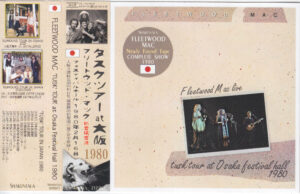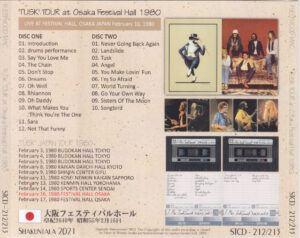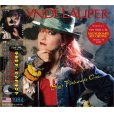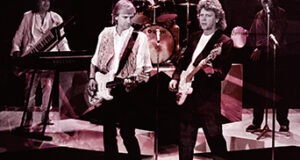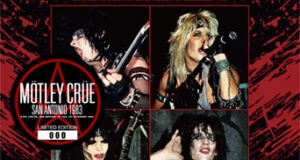Fleetwood Mac / Tusk Tour AT Osaka Festival Hall 1980 / 2CD With OBI Strip / Shakuntala
Live At Festival Hall Osaka Japan February 16, 1980. Digitally Remastered
Click Image To Enlarge
Fleetwood Mac is one of the rare bands that has been active for over 40 years. The reason why I was able to continue such a long career is, of course, the wonderfulness of the music and the extraordinary efforts such as the unity between the members who were hit by withdrawal and joining. The biggest factor is the flexible attitude of changing the musicality according to the demands of the times and the tastes of the members. The formation can be traced back to the 1960s, but the fact that it was a blues band at the beginning can only be imagined by those who only know the later blockbuster Mac.
In the late 1960s and early 1970s, the blues rock boom was coming, especially in Britain. The formation of Fleetwood Mac followed that trend, but the boom soon disappeared. Mack moved his base of activities to the United States and California in 1974, but what he saw there was not a blues but a hard rock centered on a long improvisation. Of course, the environment surrounding rock at that time could not be categorized in one word, but the sound that pushed out the whole surface while being based on blues was in a state of declining. So Mack joined Stevie Nicks on vocals and made a big turn to the pop line.
It was in 1975 that Mack, who had moved from blues rock to pop music, released his first album, “Fleetwood Mac,” which welcomed Stevie Nicks. This attempt was a huge success, and the album won number one in the US, including single hits such as “Say You Love Me” and “Rianon.” Here, Mack’s path should have been convinced. And the album “Rumor” released in 1977 will be a further hit album. Moreover, it is not just a hit album, it monopolizes the US album chart number 1 for 31 weeks, sales exceed 17 million copies, and it has become a deciding factor for Mac’s popularity as well as its reputation as a historical masterpiece. It was. The first performance in Japan is being held at that time. This was also in 1977.
The next album after the blockbuster album that established itself as a star is often over-expected and annoying to all artists, but Mack’s album “Fang” following “Rumor” is no exception at that time. Due to the rapidly changing musical trends, production is difficult. As a result, it was released as a masterpiece of a 2-disc LP. There were many experimental songs with Buckingham’s intention, and although he did well in terms of sales, he could not surpass the previous work “Rumor”. However, the world tour that accompanies the album “Fang” proved that Mac was still popular, and the number of spectators did not decline.
The tour with the album “Fang” began on October 26, 1979 in Pocatello, Idaho, and for two years, it was a large-scale trip across the entire continent, including the United States, Japan, Oceania, and Europe. The total number of performances is 111. Especially in Japan, the first visit to Japan was only 4 performances, while the 2nd visit to Japan in 1980 included Kyoto, Gifu, Sapporo, Yokohama, Sendai, and Osaka, including 3 consecutive days at Budokan. The performance was held on a scale that was very popular in Japan at that time. This work has recorded the performance on February 16th from the continuous performance of the Osaka Festival Hall, which will decorate the shime of coming to Japan in 1980. The schedule for the 1980 performance in Japan is as follows.
February 3 Nippon Budokan
February 4 Nippon Budokan
February 5 Nippon Budokan
February 8 Kyoto Kaikan Hall 1
February 9 Gifu Civic Center
February 11 Hokkaido Welfare Pension Hall
February 13 Kanagawa Kenmin Hall
February 14 Miyagi Sports Center
February 16 Osaka Festival Hall
February 17 Osaka Festival Hall
The set list is similar to the one that came to Japan in December 1977, partly because only two years have passed since the last visit to Japan, but it is an indispensable hit song of the new album “Fang”. The biggest feature is that the music is played on the stage.
This work is the first sound source that has never been on the market until now, provided by those who attended the festival hall at that time. It is a high-quality sound source that cannot be thought of as the first sound source that has never appeared in the world. The excitement of the festival hall on the day spreads in front of you. The set list selected from the paired masterpieces “Rumor” and “Fang” can still be said to be Mack’s best song selection, and it is the complete recording of it with such a first appearance sound source. It would be very lucky for Japanese fans.
From the second large-scale performance in Japan, the performance at the Osaka Festival Hall on February 16, 1980 is completely recorded with high-quality sound with the first appearance sound source. After this, the members of Mac will shift their focus to solo activities, the activity as a band will be stagnant, and the next visit to Japan will be 10 years later. In that sense, it can be said that this is the last tour where you can listen to a number of representative songs on a real-time Mac. A press board with beautiful picture disc specifications for permanent storage. With Japanese obi.
フリートウッドマックは既に40年のキャリアを超えいまだ現役で活動している稀有なバンドのひとつである。これだけ長いキャリアを継続できたのは、もちろん楽曲の素晴らしさと共に、脱退と加入に見舞われたメンバー間の結束など、並々ならぬ努力があったからに他ならない。またその要素として最大の要因は、時代の要請とメンバーの趣向に合わせ音楽性を変えていった柔軟な姿勢にある。結成は60年代まで遡ることができるが、当初はブルース・バンドであったことは後の大ヒットしたマックしか知らない人には想像だに出来ないだろう。
60年代末から70年代の黎明期には、英国を中心にブルース・ロックのブームが訪れていた。フリートウッドマックの結成はその流れに乗ったものであったが、早々にブームは廃れていく。マックは1974年に活動の拠点をアメリカ、カリフォルニアに移すが、そこで見たものはブルースではなく長大なインプロを中心としたハードなロックであった。もちろん当時のロックを取り巻く環境は一言で分類できるものではないが、ブルースを基本としつつも、それそのものを全面に押し出したサウンドは下火になっている状況であった。そこでマックはヴォーカルにスティーヴィー・ニックスを加入し、ポップ路線に大きく舵を切るのである。
下火になっていたブルース・ロックからポップ路線に移行したマックが、スティーヴィー・ニックスを迎え入れた最初のアルバム『ファンタスティック・マック』をリリースしたのは1975年の事である。この試みは大成功を収め、「セイ・ユー・ラブ・ミー」「リアノン」といったシングル・ヒットを含めアルバムは全米ナンバー1を獲得する。ここにマックの進むべき道が確信されたことであろう。そして1977年発表のアルバム『噂』はさらなるヒット・アルバムとなる。しかもただのヒット・アルバムにとどまらず、全米アルバム・チャート・ナンバー1を31週に渡って独占し、セールスは1700万枚を超え、歴史的名盤としての評価と共にマックの人気を決定づけるものとなったのである。そんな時期に初来日公演が行なわれている。これも1977年のことであった。
スターの地位を確立した大ヒット・アルバムの次のアルバムは、期待が過剰になりがちでどのアーティストも悩むものであるが、『噂』に続くマックのアルバム『牙』もその例にもれず、当時の目まぐるしく変化する音楽的流行の状況もあり、制作は難航する。その結果、なんとLP2枚組の大作としてリリースされたのである。バッキンガムの意向で実験的な曲も多くセールス的には健闘したものの、やはり前作『噂』を超えることはできなかった。しかし、アルバム『牙』に伴うワールド・ツアーは依然としてマックの人気が高い事を証明し、観客動員数は衰えることがなかったのである。
アルバム『牙』に伴うツアーは1979年10月26日アイダホ州のポカテッロから始まり、足掛け2年に渡りアメリカ、日本、オセアニア、ヨーロッパと、まさに全大陸を横断する大規模なものであった。総公演数は実に111公演を数える。特に日本においては、初来日がわずか4公演のみだったのに対し、1980年2度目の来日公演は武道館3日連続を含め、京都、岐阜、札幌、横浜、仙台、そして大阪と、10公演を行なうという、当時の日本においても高い人気が伺える規模で行なわれた。本作は、この1980年来日のシメを飾る大阪フェスティバルホール連続公演より、2月16日公演を収録している。1980年来日公演の日程は以下の通り。
2月3日 日本武道館
2月4日 日本武道館
2月5日 日本武道館
2月8日 京都会館第一ホール
2月9日 岐阜市民センター
2月11日 北海道厚生年金会館
2月13日 神奈川県民ホール
2月14日 宮城スポーツセンター
2月16日 大阪フェスティバルホール
2月17日 大阪フェスティバルホール
前回の来日から2年しか経過していないこともあって、セットリストは1977年12月の来日時のものと類似しているが、それは欠かせないヒット曲として、ニューアルバム『牙』の楽曲がステージで演奏されているのが最大の特長である。
本作は、当時フェスティバルホールに臨場した方から提供していただいた今まで一切出回っていなかった初登場音源である。今まで世に出たことがない初登場音源とは思えぬ高音質なものである。当日のフェスティバルホールの興奮が目の前に広がる。『噂』と『牙』という対をなす代表作からチョイスされたセットリストは現在でもマックの ベスト的な選曲といって良く、それをこのような初登場音源で完全収録しているのは、まさに日本のファンにとって幸運なことであろう。
二度目となった大規模な来日公演より、1980年2月16日大阪フェスティバルホール公演を、初登場音源にて高音質完全収録。この後、マックのメンバーはソロ活動に軸足を移すことになり、バンドとしての活動は停滞、次に来日するのは10年後のことである。そう言った意味では代表曲の数々をリアルタイムのマックで聴くことが出来る最後のツアーであるともいえる。美しいピクチャー・ディスク仕様の永久保存がっちりプレス盤。日本語帯付。
LIVE AT FESTIVAL HALL OSAKA JAPAN February 16, 1980
DISC ONE
01. Introduction
02. Drums performance
03. Say You Love Me
04. The Chain
05. Don’t Stop
06. Dreams
07. Oh Well
08. Rhiannon
09. Oh Daddy
10. What Makes You Think You’re The One
11. Sara
12. Not That Funny
DISC TWO
01. Never Going Back Again
02. Landslide
03. Tusk
04. Angel
05. You Make Lovin’ Fun
06. I’m So Afraid
07. World Turning
08. Go Your Own Way
09. Sisters Of The Moon
10. Songbird
Shakuntala. STCD-212/213
 GiGinJapan Artwork of Japanese CDs (mostly)
GiGinJapan Artwork of Japanese CDs (mostly) 